Djordje Ozbolt
Regaining Memory Loss
Il Padiglione della Repubblica di Serbia alla 58. Esposizione Internazionale d’Arte - La Biennale di Venezia, espone nuovi dipinti e sculture di Djordje Ozbolt i quali affrontano la memoria, sia personale che collettiva. L'installazione di Ozbolt, intitolata " Riacquistare la perdita di memoria ", è stata creata in risposta al patrimonio culturale e politico del Padiglione. Incorporando le memorie dei suoi primi anni di vita, il lavoro di Ozbolt esplora il modo in cui un passato personale può coesistere con storie culturali e politiche incise. I dipinti e le sculture del Padiglione espongono il tentativo dell'artista di riconciliare i suoi ricordi personali con le sue narrazioni e in continua trasformazione.
Il linguaggio visivo dell'artista, formato in un contesto storico distinto, mette in discussione - a volte con umorismo - l'incarnazione concreta della storia. L’arte di Ozbolt è caratterizzata da una incessante incorporazione di immagini visive eclettiche. I lavori esposti nel Padiglione presentano il linguaggio ampliato per incorporare riferimenti molto personali che provengono da un patrimonio architettonico e culturale condiviso e riconoscibile. Stratificando il suo stile fantasioso e colorato assieme a questi ricordi frammentati, il lavoro di Ozbolt mette in discussione la misura in cui la storia è un'interpretazione soggettiva, sia nel suo inconscio che nelle sue consuete retoriche.
Il padiglione serbo si trasforma grazie ad un nuovo dipinto murale di Ozbolt, che al suo interno incorpora più dipinti, fungendo da paesaggio immaginario. Ozbolt vede queste opere come finestre o portali che si aprono a visioni simboliche e illusorie del passato. Attraverso l'uso caratteristico dell'artista di colori brillanti e saturi, le tele e le pitture murali si scontrano e combattono creando una sorta di storia inaffidabile.
In una serie di sculture, Ozbolt considera la figura umana come un simbolo di idealismo. Incorporazione di rappresentazioni scultoree storiche di questo idealismo attinge anche al simbolismo dei monumenti jugoslavi, che spesso raffiguravano operai e contadini come eroi. Ozbolt sovverte scherzosamente questi archetipi, aggiungendo aspirazioni sociali contemporanee di yoga e machismo. Queste sculture evidenziano come gli
emblemi si spostino tra contesti storici, assumendo una forma di nuova allegoria che è sempre altamente politica e sociale, ma anche determinata da una percezione personale inaffidabile.
Le sculture e i dipinti sono configurati per guardarsi l'un l'altro, ciascuno riflettendo all'altro la stratificazione di frammenti selettivi di memoria. Le opere in sé sono interpretazioni, una visione soggettiva del passato dalla prospettiva del momento presente. Ozbolt interroga il ruolo dell'opera d'arte nel distillare la verità: nella sua immaginaria irrealtà, le opere rivelano la loro memoria come falsa, mentre come rappresentazioni artistiche sono vere.
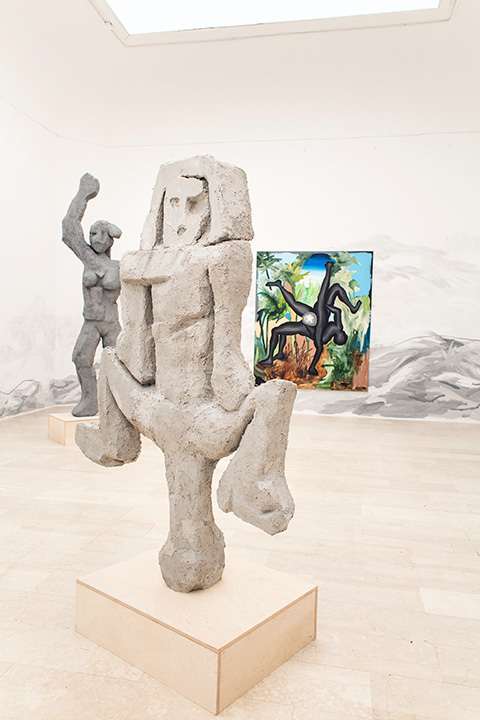 Djordje Ozbolt, Regaining Memory Loss, 2019. Serbian Pavilion, Biennale Arte 2019 Foto Francesco Galli
Djordje Ozbolt, Regaining Memory Loss, 2019. Serbian Pavilion, Biennale Arte 2019 Foto Francesco Galli
A brief history of memory
Nicoletta Lambertucci
Plato recognised a distinction between the conservation of a sensation and reminiscence. The first one is the conservation, in some form, of past knowledge, which is not visible anymore. Reminiscence is instead the ability to recall, when needed, past information and to make it present and actual. Later on Aristotle uses the same distinction and asks: If something similar to a trace (or an image) stays with us, how can the perception of it be the memory of something else which is not the trace itself? The answer will be: a painted animal in a painting is a depiction of the animal (the painting) and also the animal that is depicted. It is both things. In the same way the mnemonic image should be considered both as an object in itself and as the representation of something else. Furthermore, reminiscence has another fundamental element: it is a voluntary action.
In his work Djordje Ozbolt makes use of both the ‘conservative’ and the ‘reminiscent’ aspect of memory. The project presented for the 2019 Serbian Pavilion is a reflection on how the latter is based on imagination, emotions and individual choices. It also establishes the impossibility of a purely conservative memory but plays with the common understanding of it as fixed, static knowledge.
The conservation aspect of the concept of memory has an interesting development with the medieval philosophers. Saint Thomas defines memory as ‘the treasure and the places of species’ preservation’. Saint Augustine sees memory as the full conservation of the spirit: of all its actions, manifestations or ways of being. Leibniz speaks about conservation as a form of virtuality. In transcendentalist philosophy the so-called Spirit has the power of self-preservation in some virtual or other form.
Similarly to these ideas, history and geographies are compressed and flattened in the work of Djordje Ozbolt. The new series of paintings presented include references that, rather than being informative and acknowledging specific situations, present a plethora of possibilities, where undefined characters or objects play in a colourful, complex and abstracted version of our world. In the work XXX, for instance, two figures are hugging each other, or perhaps they fight and the larger figure holds a weapon. The landscape could be reminiscent of a modern city, where green areas are mixed with occupied zones, and darker parts are lit by blue skies. It could also be an illustration of a dream. It feels as if all the information is condensed in a singular plane of possibilities.
In theosophy and anthroposophy, the Akashic records are a compendium of all human events, thoughts, words, emotions, and intent ever to have occurred in the past, present, or future. They are believed by theosophists to be encoded in a non-physical plane of existence known as the etheric plane.
The paintings in Regaining Memory Loss feel like one possible representation of this notion: a cluster of ideas had taken shape, created constructions, futuristic ships, explosions, codes…and they are all living in one image, in one dimension.
The prerequisite is similar: that of a total and full conservation of everything.
The phenomenon of remembering is tied with the content’s process from an actual to a potential state and the other way around. In XXX, what looks like a repetition of three stylised clenched fists inhabits the central part of the canvas, and a world of green, pink and blue is generated from them, around them. Symbols are degraded to the level of props. Intentionally misleading, Ozbolt uses them to confuse, to question the norm. The visual deconstruction of the symbolic element is combined with the amalgamation of those symbols with disparate other elements in order to create an organic new being, which is not recognizable; it is a new creature.
Probably the most known exposition of memory is the one by Henri Bergson who, in Matter and Memory, published in1896, affirms that memory is not the regression from the present back to the past but on the contrary it is the progress from the past to the present. In fact, it is in the past that we suddenly locate ourselves. Immanuel Kant was accused by Henri Bergson of confusing time with its spatial representation. Instead, what Bergson identified as duration was a free, mobile and heterogeneous concept that is still valid in contemporary psychology. ‘The flux of time is the reality itself, and the things which we study are the things which flow’, he famously stated. In Ozbolt’s project for the Venice Biennale, the focus is this constant flow of things, which makes them change in our mind and therefore modify the way we relate to them.
Djordje Ozbolt was born in Belgrade in 1966, and grew up in a context that felt safe, small, ‘it was as if I knew everyone!’. Then the wars changed the city, people flew, bombing erased parts of it. The paintings presented in the pavilion are the traces of those memories, which are now mixed with the idealisation of a moment in time. Ozbolt relocates himself in the past and acknowledges through these new works that what we remember is always an entirely new image and it is the fruit of the work of time and of all the experiences that occurred afterwards.
The paintings in the exhibition are recognizable works by Ozbolt: sharp, colourful, full of wit and of a sense of illogicality that is given through a fusion of elements that are rationally disconnected yet intuitively combined. The title also, is an emblematic Ozbolt’s word play, where irony is employed to create a short circuit of meanings. How can one regain a memory loss? If memory is the main subject in Ozbolt’s project for the Biennale, it does not come without complications. Memory is a slippery thing, and the past becomes an unstable, dangerous zone to access. The images that Ozbolt depicts are his own understanding of memory: a personal, anew, non-linear impression of the mind. That’s why the images appear so fresh, almost the contrary to those black and white photograph of past times.
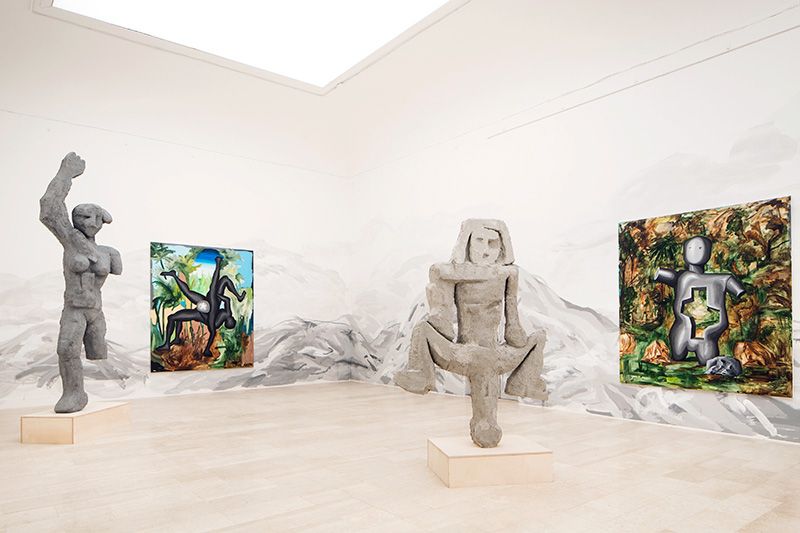 Djordje Ozbolt, Regaining Memory Loss, 2019. Serbian Pavilion, Biennale Arte 2019 Foto Francesco Galli
Djordje Ozbolt, Regaining Memory Loss, 2019. Serbian Pavilion, Biennale Arte 2019 Foto Francesco Galli
Let go and make the work
You grow up in a certain place and that certainly stays with you even if you are not aware of it. I’ve never tried to figure out what element that is, but I’m sure it’s present [in the work] even if it’s just a way of thinking and seeing things. Even with a Western education, that stays with you. You see through those eyes.
In the series of paintings made for Regaining Memory Loss, deconstructed buildings, monuments and human figures in sculptural poses populate the canvases. Some more recognizable than others, these features are symbols of Ozbolt’s childhood while representing a very precise historical moment. Monuments and memorials to the revolution and the victims of the Second World War were school trips destinations that Ozbolt recalls as moments of fun with his friends. At the time, those memorials where almost invisible to him, while today they resurface as ghosts and are capable of triggering an emotional response. If, on one hand, they reclaim their rightful artistic value as sculptures they also are brand new containers of fresh stories. Past and its current significance is questioned and the ideals that those monuments where built upon are now distant, opaque. The symbols of idealised figures and attitudes are now living in a canvas that is full of cheerful colours and where certainties have lost meaning. Often positioned in the middle of the painting, they become however unrecognizable, they are just an inspiration to present something else. Always maintaining a degree of figuration, they are developed into abstract shapes, into new symbols, dressed with the vivid, saturated colours of the imagination.
In XXX the abstract, almost fluid, grey shape is surrounded by an abundance of different forms, interlinked narratives and geometrical patches of sky-blue colour and pink and at the top a thin silhouette of a monument gives the only hint of structure to the image. In XXX instead, Ozbolt depicts the back of a naked woman in the middle of a landscape that feels desolated. Her white bottom is centred in the canvas and her clenched fist, also white, seems to point at a distant, solitary monument. Ozbolt never censors himself and takes outrageous chances that instill freedom and courage. The artist could be considered an entertainer, but works are not distracting and instead have a strong impact and they call for engagement.
A massive wall painting embraces the works creating a shared landscape, uniting the dots like if they were all memories that needed to be connected to make sense, or stars in a sky that form a unique constellation. Ozbolt employed wall paintings previously. The first time on the occasion of his solo show at Hauser and Wirth Somerset in 2017, titled Brave New World and subsequently for the project presented at the first Belgrade Biennial, Marvellous Cacophony, where he depicted a thick jungle as a background for the paintings. The wall painting highlights the works so they can better narrate new stories of a time that is unreliable, fragmented and fragile. They seem to communicate that history is what we, in the present moment, make of it.
A keen traveller, the artist visited many places, but it is India that particularly captured his interest so much so that he moved to the Himalayas and lived there for almost two years with his wife. While travelling the whole country Ozbolt never stopped painting and that was a time when colours fiercely entered his canvases, never to leave them. India’s rich culture and imagery is a constant source of inspiration and often present in the paintings. In Pearls of Wisdom, 2014 a central figure dressed in typical Indian clothes, turban and pointy slippers is holding on to a stick. His face is made of grey twisted brushstrokes and it may look like an oyster; from the hole/mouth pearls are coming out to form a pattern on the left side of the canvas. The landscape is dreamy, reminiscent of a Leonardo Da Vinci’s foggy, rocky dawn. In Silent Dialogue, 2010, a solitary Lion tailed macaque (one of the most endangered species in India) smokes a pipe in a setting that gradually gets more and more psychedelic. In an earlier work from 2006, Dodo and Friend, a figure dressed in archetypal Indian trousers and slippers touches the extinct flightless bird in a scene made of palm trees and a bright scenic blue sky. In Benares, 2005 a scene from the city of Benares (known as Varanasi) depicts Hindu pilgrims bathing in the Ganges River’s sacred waters, performing funeral rites.
Ozbolt’s paintings can appear enigmatic, but the images produced are always immediate, genuine and crisp. The artist has stated several times that for him the work must come from a place of thought-less mind, tapping into the unconscious, working before a rational, logical thought arrives to interrogate and to analyse. An interesting example of this mode of working is 50 Ways to Leave your Lover, a work from 2015 shown as part of his solo exhibition in New York titled More Paintings About Poets and Food. This installation of fifty paintings was exhibited in a continuous line: a linear presentation of the anti-narrative artist’s riotous mind. Taking its title from Paul Simon’s 1975 song, the paintings are diverse in technique and content, mixing politics with pop culture; geometric blocks of paint are alternated with busy, rough and bold brushstrokes. Painted in only a three-month period, scenes of the absurd are next to more abstract moments, making the work a diary of his (unconscious) mind in a specific moment in time. The fifty paintings playfully show Ozbolt’s mastery of paint and his interest in the immediate, in that space which is not rational, not reflected, but true and pure.
Like in meditation, where the focus is the breath or a mantra and the goal is to let the thoughts pass by without caring for them, similarly painting for Ozbolt is a question of pre-thinking, pre-rationalising. That’s why his work has often been linked with the Surrealists, as they in fact tried to access the sphere of the unconscious, where the rational mind has no influence or power. Some paintings have two or three paintings underneath that the artist has repainted with something entirely different. Nonetheless the immediacy of the final work is certainly one of Ozbolt’s most recognizable traits. The imagery that the artist delves in is a mixture of classical genres from still life to portraiture with symbols and subjects sourced from African Art, Christianity and history of painting and their clichés. Ozbolt once stated: ‘The way I work is just to let go and make the work. My thing in a way is that you have eclectic paintings shown together. So it is one body of work but it might appear as random.’
Often playing with the status of what a work of art is – whether by mimicking old masters or portraying Mayakovsky with an ice cream cone stuck in his forehead (Mayakovsky’s nightmare, 2013), or in the Disney series where he depicts Bambie and other characters from the famous movies – he also masterfully shifts between styles. In his first exhibition at Herald Street in 2006, titled Wanderings of a Pilgrim in Search of the Picturesque, his talent in working on different styles is outstanding. Ranging from a rounded board depicting St Jerome in a classical religious pose with a long white beard (The Penitent St Jerome, 2006) to a painting like Expressionist Anger Management, where a furious stylized face gets lost in a jungle of red and black thick brushstrokes.
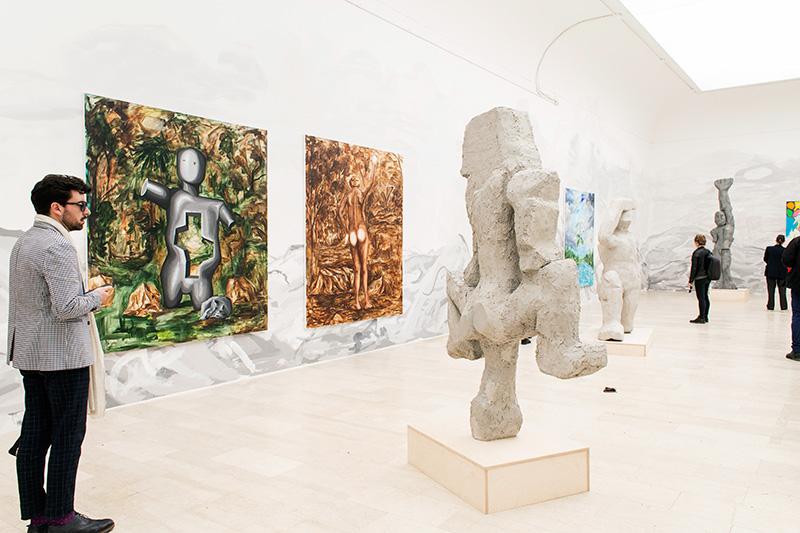 Djordje Ozbolt, Regaining Memory Loss, 2019. Serbian Pavilion, Biennale Arte 2019 Foto Francesco Galli
Djordje Ozbolt, Regaining Memory Loss, 2019. Serbian Pavilion, Biennale Arte 2019 Foto Francesco Galli
Aliens, Gods and demigods
Five 2-meter tall sculptures welcome the visitor into the pavilion. Looking heavy in grades of grey they are made of what appears to be solid stone, concrete, or perhaps plaster. Produced in Belgrade by a Swiss fabricator, they are made of cut polystyrene coated in plexiglass and eventually covered in resin, which contains finely grounded stone and pigment. Finally, to give the matt effect, they get sandblasted.
Impressive, they depict human figures in different postures and actions; one seems to be in the classic yoga ‘warrior’ pose, three of them have clenched fists, another stands on its penis, legs up, looking straight ahead fiercely, proudly. Limbs are sometimes missing. Their appearance resemble Neolithic sculptures or the Easter Island’s Moai or even blown up propitiatory statuettes. Some are direct reference to the sculptures from Ozbolt’s youth, in emblematic revolutionary postures, promoting values from another time, presenting grand ideals in a post revolutionary world. Maybe that’s why they are missing parts, as if time and human nature have failed and consumed them. They could be aliens from another world or what remains of ancient gods and their power.
Ozbolt started making sculptures more than a decade ago, and he considers them as extensions of his paintings. The canvases did not cover all the artist’s intentions and sculpture felt like a medium that could complete the realisation of an idea, at times by simply being a 3D achievement of what is depicted in the paintings. Therefore, the sculptures would complement the paintings and vice versa. In 2013, on the occasion of his Hauser and Wirth solo exhibition in Zurich Who Say Jah No Dread? Ozbolt collided traditional European genres with African motifs. In the pseudo portraits painting, each subject has an African mask for a head (a theme that he already explored in a previous exhibition at Herald Street in 2011), which is then translated into three-dimensional form in an arranged group of similar mask sculptures, titled Plastic Fantastic, made of vividly coloured resin.
In 2016 on the occasion of his solo show The Grand DeTour at the Holburne Museum in Bath, Ozbolt directly responded to the historical collection with a series of paintings that playfully fused history, mythology, pop culture and religion. A group of garden gnomes inhabited the outside spaces of the museum, humorously playing with the solemnity of the context, being irrevocably out of place, but at the same time nodding at the refugee crisis. In fact, the gnomes were produced in Serbia and ‘they’re like fellow countrymen -he stated - in search of a better life in the West.’
The term “alien” is derived from the Latin alienus, meaning stranger, foreign, “belonging (somewhere) else”. In legal terms, an alien is a person who is not a national of a given country. In the United States of America for instance, a person who is not a citizen of the United States and is legally living in the country is known as “permanent resident alien”. Similarly to the gnomes that were occupying the museum’s garden in Bath, the figures in the pavilion are aliens, belonging to some other undefined time - perhaps the future - and some other place, seeming lost in their awkward, defective solemnity.
Regaining Memory Loss is yet another example of the painting/sculpture relationship and together the artworks generate Ozbolt’s world of paradoxes where old grand ideals coexist with enigmatic, illogical interrogations, every work being like a kōan. A kōan in Zen practice is an unanswerable question or an apparent meaningless statement. However, a kōan is not meaningless, and not a riddle or a puzzle. Teachers do expect students to present an appropriate response when asked about a kōan, and meditating a lifetime over the given kōan can lead to enlightenment. In a similar manner, the works in the pavilion are like portals, puzzling and ironic images to meditate upon, a contemplation that will hopefully lead to an understanding of the past and the present as fallible concepts, of ideologies and ideals as frail and shaky.
Ideologies, figures of authority and religions have often been questioned with great ability and sharpness by Ozbolt, who employs humour to challenge certainties and power relations. His enquiry into the idiosyncrasies of human nature and the extremities of belief has brought him to directly look at his own personal history and to tie it with the complex socio-political history of the Balkans. In Regaining Memory Loss, the artist has indeed taken on a slightly different task. While maintaining his unique style and approach to the work, the project has a much more personal, intimate foundation that paradoxically ends up expressing a broader national and institutional significance. It is a reflection, a discourse on life as a timed journey that feels exclusively personal, but that instead gets intertwined with millions of other individual stories, memories and emotions.
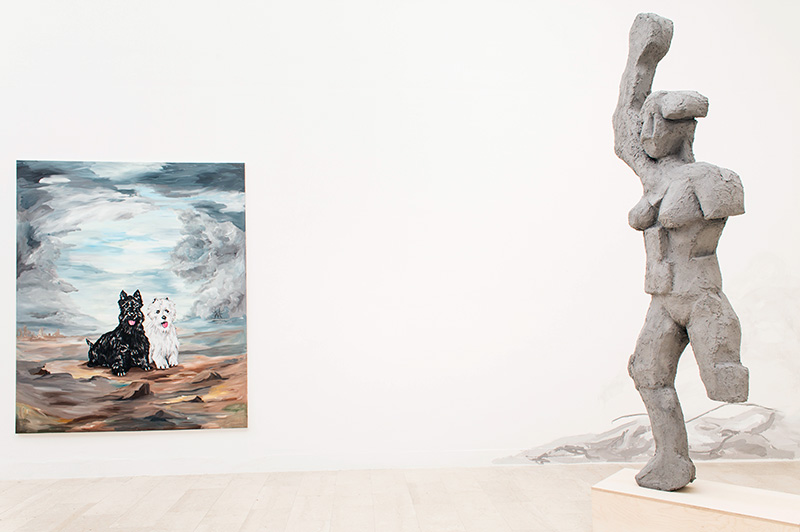 Djordje Ozbolt, Regaining Memory Loss, 2019. Serbian Pavilion, Biennale Arte 2019 Foto Francesco Galli
Djordje Ozbolt, Regaining Memory Loss, 2019. Serbian Pavilion, Biennale Arte 2019 Foto Francesco Galli
On diversity
The inaccuracy is the beauty of a painting
The Venice Biennale, established in 1895, is currently the only biennale that uses the model of national pavilions. Early criticism of this format arrived in the 60s, with postcolonial movements and students uprising. Representing a nation through its best artistic agents has a reactionary aspect that can be mitigated and even challenged by the project outcomes. The selected artists and curators are asked to produce content that represent the national identity in an international institutional context and the exhibition should propose insights into the artistic national scene and its relation to the rest of the world.
The Serbian Pavilion is situated along the north edge of the Biennale grounds between Egypt and Austria, and faces both the Giardini and the city. Following the principles of the Italian rationalism of the Mussolini era, the building has written above the portal the inscription Yugoslavia.
In the process of inheritance of Yugoslav property abroad, the Yugoslav Pavilion came under the ownership of the Republic of Serbia; a small inscription “Serbia” indicates it on the right of the portal. In 2006 with Montenegro’s independence granted, Serbia declared itself an independent state, the first time it had been so since 1918. This also ended Yugoslavia’s 88-year existence. As one enters the pavilion and passes under the title Yugoslavia, we are faced with the paradox of time: the past is a changeable element, memories are unpredictable, and they become truth for just a moment, before being forgotten again.
Ozbolt moved to London in 1991, where he studied Fine Art (at Chelsea College, Slade and Royal Academy) but he never lost connection with his origins and people in Serbia.
However one of the most fascinating elements in Ozbolt’s work that is reflected in his project for the pavilion is the burning curiosity and interest in exploring the Otherness, the different, diverse places and cultures. Rather than offering a definitive representation of a specific society or ideal, Ozbolt brings to his national pavilion an idiosyncratic and eclectic body of works that convey various cultures, experiences, mixed feelings and disparate origins. The artist’s works are loaded with icons, and emblems. He grew up surrounded by symbols of power: Christian Orthodox, Christian Catholic, as well as communist and gangster culture. All these codes have been mixed without any hierarchy; instead they have been interrogated in the intrinsic relevance that is usually afforded to figures of authority. Yet they all come together to create a strong, coherent identity.
In dreams, it is said that every character that you dream of is an unconscious representation of a part of you and in a similar manner, at the heart of an artistic practice there is always the artist herself/himself. Through the lens of the huge range of colours, shapes, symbols and references that inhabit Ozbolt’s works, a clear and distinctive sensibility comes to the fore: it is one that speaks of embracing diversity, accepting one’s own story and making it anew through exotic experiences, a wide-ranging curiosity and always using a touch of humour.
Padiglione della Serbia alla 58. Esposizione Internazionale d’Arte – La Biennale di Venezia




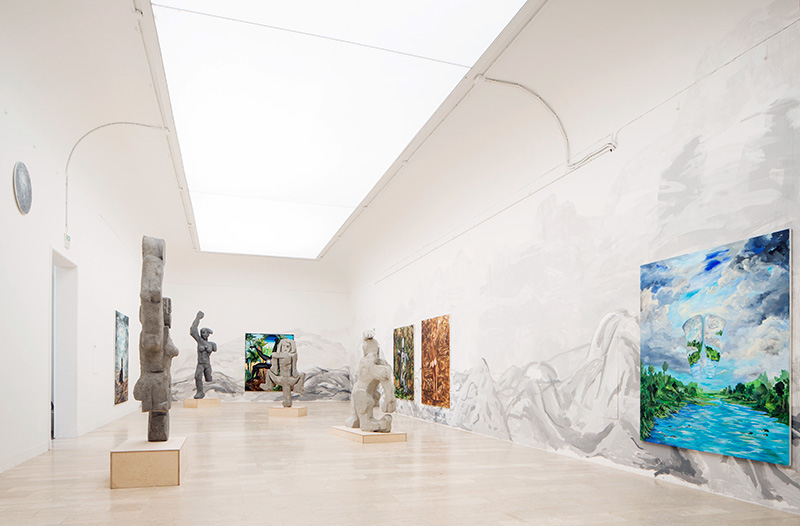 Djordje Ozbolt,
Regaining Memory Loss, 2019. Serbian Pavilion, Biennale Arte 2019 Foto Francesco Galli
Djordje Ozbolt,
Regaining Memory Loss, 2019. Serbian Pavilion, Biennale Arte 2019 Foto Francesco Galli Djordje Ozbolt, Regaining Memory Loss, 2019. Serbian Pavilion, Biennale Arte 2019 Foto Francesco Galli
Djordje Ozbolt, Regaining Memory Loss, 2019. Serbian Pavilion, Biennale Arte 2019 Foto Francesco Galli Djordje Ozbolt, Regaining Memory Loss, 2019. Serbian Pavilion, Biennale Arte 2019 Foto Francesco Galli
Djordje Ozbolt, Regaining Memory Loss, 2019. Serbian Pavilion, Biennale Arte 2019 Foto Francesco Galli Djordje Ozbolt, Regaining Memory Loss, 2019. Serbian Pavilion, Biennale Arte 2019 Foto Francesco Galli
Djordje Ozbolt, Regaining Memory Loss, 2019. Serbian Pavilion, Biennale Arte 2019 Foto Francesco Galli Djordje Ozbolt, Regaining Memory Loss, 2019. Serbian Pavilion, Biennale Arte 2019 Foto Francesco Galli
Djordje Ozbolt, Regaining Memory Loss, 2019. Serbian Pavilion, Biennale Arte 2019 Foto Francesco Galli